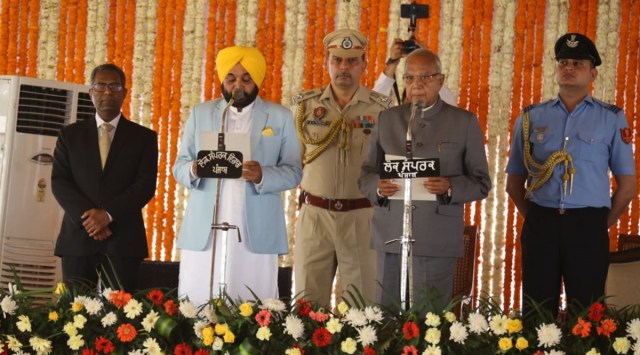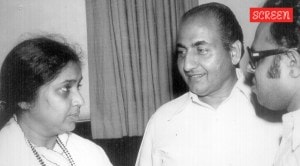Bhagat and Bismil, how AAP married iconography at Mann swearing-in
The venue of Punjab Chief Minister Bhagwant Mann’s swearing-in ceremony at Bhagat Singh’s village Khatkar Kalan reverberated with the iconic revolutionary song “Mera rang de Basanti chola”
 Bhagwant Mann takes oath as Punjab CM (Express photo by Gurmeet Singh)
Bhagwant Mann takes oath as Punjab CM (Express photo by Gurmeet Singh)Amid a sea of “basanti” turbans, the venue of Punjab Chief Minister Bhagwant Mann’s swearing-in ceremony at Bhagat Singh’s village Khatkar Kalan reverberated with the iconic revolutionary song “Mera rang de Basanti chola” on Wednesday.
This was in line with the Aam Aadmi Party’s (AAP) designated theme of “Rang de Basanti” for the oath ceremony — illustrating the party’s strategy of not allowing only the BJP to lay claim to nationalist iconography. Mera rang de Basanti chola was penned by Bhagat Singh’s fellow revolutionary Ram Prasad Bismil and other prisoners in 1927 while they were incarcerated in a jail in Lucknow.
Who was Ram Prasad Bismil?
The revolutionary leader was born on June 11, 1897, in a village in Uttar Pradesh’s Shahjahanpur district, and was associated with the Arya Samaj from an early age.
From quite early on, he wrote powerful patriotic poems in Urdu and Hindi and became active in the anti-colonial struggle under the guidance of his guru Swami Somdev.
Bismil was 18 years old when he wrote the poem Mera Janm (My Birth) in protest against the death sentence handed to nationalist leader Bhai Parmanand in the 1915 Lahore conspiracy trial following the failed Ghadar plan to instigate a mutiny in the British Indian Army. The poem illustrated Bismil’s commitment to revolutionary ideals and ending colonial rule in India.
Bismil prominently showed up on the colonial government’s radar three years later at the time of the Mainpuri conspiracy that was spearheaded by Genda Lal Dixit, a schoolteacher from Auraiya. He evaded arrest and was declared an absconder in the case. After the British king issued a pardon in 1920, those jailed in the Mainpuri case were released, and Bismil, who had been on the run till then, returned to Shahjahanpur in February 1920.
Founding the HRA
Soon afterwards, Bismil became active in the Congress, but his political position was in stark opposition to Mahatma Gandhi’s principle of non-violence. As Gandhi suspended the Non-Cooperation movement following the Chauri-Chaura incident on February 4, 1922, Bismil was among scores of disillusioned workers and leaders who left the Congress. Veterans such as Bismil, Jogesh Chatterjea, and Sachindranath Sanyal met in Kapur in October 1924 and set up the Hindustan Republican Association (HRA).
Among those who joined the organisation at the time was Bhagat Singh. Soon after, the outfit changed its name to the Hindustan Socialist Republican Association. In its manifesto, titled The Revolutionary, the organisation clarified its ideological position. Though the revolutionaries did not make any reference to socialism, they spoke of class struggle, nationalising major industries, and setting up cooperative unions. The organisation also reiterated its commitment to secularism.
Kakori train robbery and trial
To fund arms procurement for the HRA, 10 revolutionaries under Bismil’s leadership held up the 8-Down train at Kakori, a village near Lucknow, on August 9, 1925, and looted the railway’s cash. Scores of revolutionaries were arrested in a swift retaliation by the colonial government. Bismil was arrested in September 1926.
After a lengthy trial that lasted one-and-a-half years, Bismil, Roshan Singh, Rajendra Lahiri, and Ashfaqulla Khan were sentenced to death in April 1927, four others were sent to the Port Blair Cellular Jail in the Andamans for life, and 17 others received long prison terms.
Khan, Bismil, and Singh were hanged on December 19 that year in different prisons, two days after Lahiri was executed.
In his final days, Bismil was lodged in Barrack number 11 of Lucknow Central Jail. There, he wrote his autobiography, which is considered to be one of the finest works in Hindi literature, and came up with the song that continues to echo in Indian politics even now.







